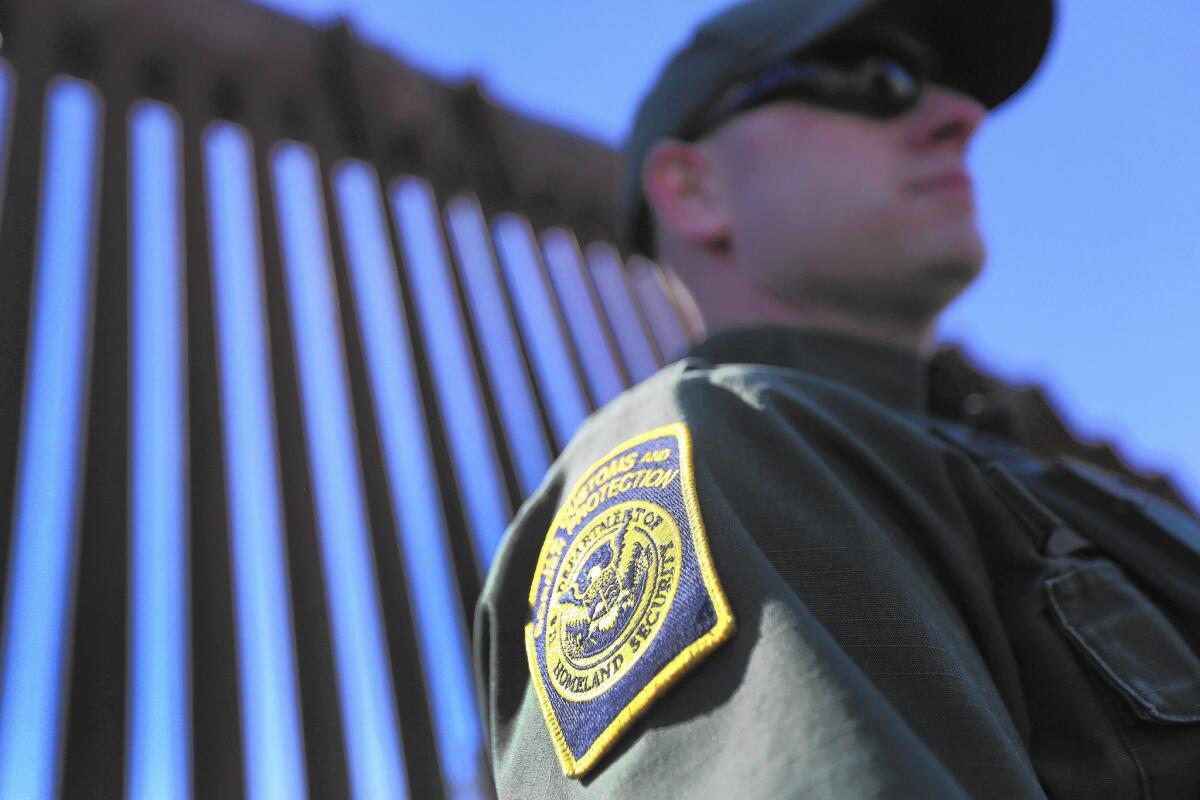New guidelines issued to Border Patrol on use of deadly force

- Share via
Reporting from Washington — Homeland Security officials on Friday released revised instructions for when Border Patrol agents can use deadly force, but questions remained over how rigidly the new rules would be enforced by agents in the field.
The guidelines are intended to respond to concerns raised in a scathing internal report, first obtained by The Times in February, that found Border Patrol agents had deliberately stepped in front of moving cars apparently to justify shooting at drivers, and had fired in frustration at people throwing rocks from the Mexican side of the border.
At least 20 people have been killed in confrontations with Border Patrol agents since January 2010. In at least nine cases, agents said they were pelted with rocks before they responded with lethal force. Six people, including three minors, were standing across the border in Mexico when they were shot to death.
The new instructions expressly prohibit agents from shooting at the operator of a moving vehicle unless the driver poses a deadly threat to an officer or another person. When agents are faced with “thrown or launched projectiles,” they are encouraged to seek cover or move out of range, if possible, and are told not to fire in response unless the projectiles are large enough to cause “serious physical injury or death.”
A Border Patrol union leader said he saw no substantial change in the agency’s rules. The union has vowed to oppose any measures that restrict the ability of agents to defend themselves.
“[The agency] realized the unique environment we are in and kept in place the ability to defend ourselves against vehicular assaults and stone attacks,” Shawn Moran, the vice president of the Border Patrol agents’ union, said in a telephone interview from San Diego.
Asked whether the new instructions represented a shift in policy, Gil Kerlikowske, the head of Customs and Border Protection, said in a news conference that “something has changed and very much.”
Kerlikowske promised to be more open about clarifying when agents are allowed to use force and said that there would be more scrutiny from Border Patrol managers when deadly force is used.
But Kerlikowske refused to say how many agents had been disciplined for violations of the use-of-force policy since 2010. Recently released records showed that during a three-year period ending January 2012, only 13 of 809 abuse complaints sent to the Border Patrol’s internal affairs unit led to disciplinary action.
He said holding agents accountable was something that needed “improvement” and that many investigations, which involve multiple agencies, had not been completed.
The new policy also requires mandatory drug testing for any agent who uses deadly force, a practice that is standard in major metropolitan police departments but has not been in place for Border Patrol agents. It also requires agents carry “less lethal” weapons, such as pepper spray, Tasers and guns that shoot rubber pellets.
Vicki Gaubeca, the director of the American Civil Liberties Union of New Mexico’s Regional Center for Border Rights, welcomed the changes.
“It will still be important to see how these revised policies on use of force are translated into training and the agency will require monitoring to ensure that agents who violate these new policies are held accountable,” Gaubeca said.
On Friday, the agency publicly released for the first time its internal report on border violence. For months Customs and Border Protection officials had refused to release the report to lawmakers and news outlets on the grounds that it might compromise sensitive law enforcement information and endanger Border Patrol agents.
The report recommended that border agents be barred from shooting at vehicles unless their occupants were trying to kill them. It also recommended that agents be prohibited from shooting at people throwing things that could not cause serious harm. In its initial internal response, also obtained by The Times, the agency rejected those recommendations, saying they would compromise agents’ security.
In March, however, a directive from Border Patrol Chief Michael Fisher reversed that decision and introduced new standards on the use of force that largely track with the instructions announced Friday.
The Border Patrol said last year that the agency would consider equipping agents with lapel cameras that could provide a record of deadly force incidents and protect agents from false accusations. Kerlikowske said Friday that the agency was still studying the idea.
More to Read
Sign up for Essential California
The most important California stories and recommendations in your inbox every morning.
You may occasionally receive promotional content from the Los Angeles Times.














